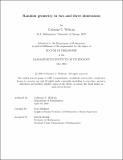| dc.contributor.advisor | Sheffield, Scott | |
| dc.contributor.author | Wolfram, Catherine C. | |
| dc.date.accessioned | 2024-06-27T19:45:16Z | |
| dc.date.available | 2024-06-27T19:45:16Z | |
| dc.date.issued | 2024-05 | |
| dc.date.submitted | 2024-05-15T16:21:06.117Z | |
| dc.identifier.uri | https://hdl.handle.net/1721.1/155328 | |
| dc.description.abstract | A central theme in random geometry is the interplay between discrete models and continuum ones that appear in scaling limits. Surprising structure and symmetry often arises in these scaling limits, leading to an interplay between combinatorics, probability, complex analysis, and geometry. The dimer model is one of the classical lattice models of statistical mechanics and can be defined in any dimension. In the first half of this thesis, we prove a large deviation principle for dimer tilings in three dimensions. This generalizes a two-dimensional result of Cohn, Kenyon, and Propp, and is one of the first results for dimers in any dimension d > 2. Many ideas and constructions used to study dimers are specific to two dimensions, so our arguments start from a smaller set of tools including Hall’s matching theorem, the qualitative description of the Gibbs property, and a double dimer swapping operation. In the second half of this thesis, we study discrete, geometrically-motivated coordinates called shears on the space of circle homeomorphisms up to Möbius transformations. The Weil–Petersson Teichmüller space is a subspace of this which has been of long-term interest in geometry and string theory and has recent connections to SLE curves in probability. We introduce and study natural ℓ2 spaces in terms of shears, and obtain sharp results comparing them to Hölder classes of circle homeomorphisms and the Weil–Petersson class. We also give a preliminary result about i.i.d. Gaussian random shears. | |
| dc.publisher | Massachusetts Institute of Technology | |
| dc.rights | In Copyright - Educational Use Permitted | |
| dc.rights | Copyright retained by author(s) | |
| dc.rights.uri | https://rightsstatements.org/page/InC-EDU/1.0/ | |
| dc.title | Random geometry in two and three dimensions | |
| dc.type | Thesis | |
| dc.description.degree | Ph.D. | |
| dc.contributor.department | Massachusetts Institute of Technology. Department of Mathematics | |
| mit.thesis.degree | Doctoral | |
| thesis.degree.name | Doctor of Philosophy | |
